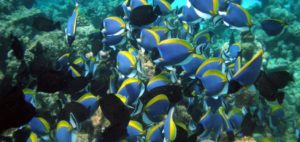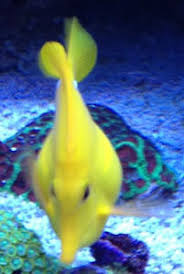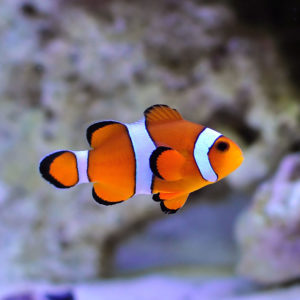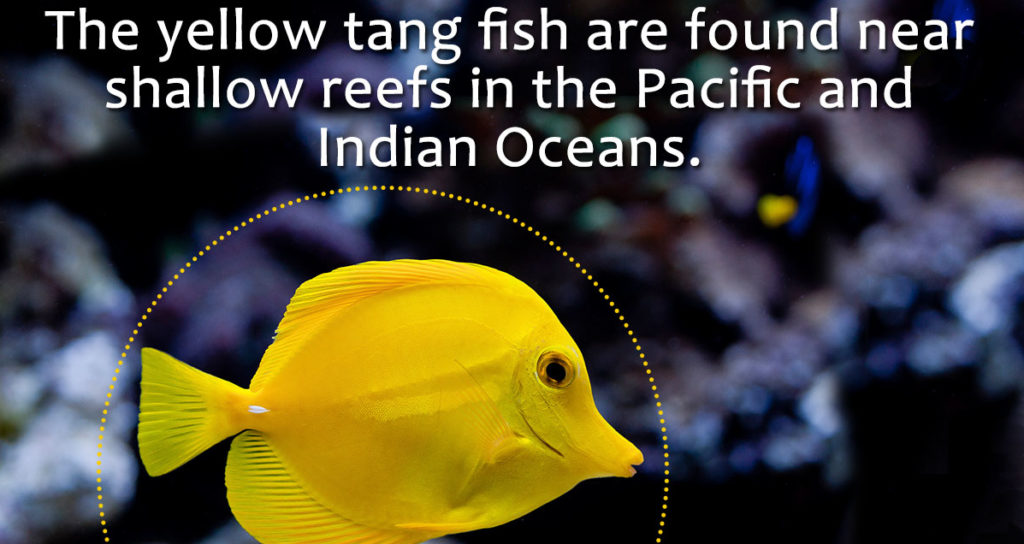The Yellow sailfin tangs or Zebrasoma flavescens in scientific terms, are a wonderful addition to any aquarium. Don’t miss this wonderful opportunity to learn everything about them.
Table Of Content
Taxonomy
Domain: Eukaryota Animalia Kingdom Phylum: Chordata Class: Actinopterygii Order: Perciformes Family: canthuridae Genre: Zebrasoma Species: Z. flavescens
Surgeon Fish:
Worldwide, the surgeons’ fish family includes more than 70 species in tropical seas. They owe their name to a sharp spine or «scalpel» that they have at the base of the tail and use to defend themselves.
In fact the Acanthuridae family’s scientific name, means “spinned tail “in Greek. The local species share the same shape and similar colors, which complicates their differentiation.
To complicate things further, the color may vary within the same species, and individuals of different species form mixed groupings.
They are diurnal, and they are seen crossing the reef in these groups, feeding on algae.
They prevent them from overgrowing and suffocate the reef, so the presence of surgeons is critical to the reef’s overall health.
Yellow Sailfin Tangs’ Main Traits
The yellow sailfin tangs are easily identified by their bright color, oval bodies and flag-shaped tails and their also yellow pectoral fins.
Adults have a narrow line of dark color along their dorsal fin that curves backwards in the tail.
However, their body color changes as they mature, according to the Animal Diversity Network (ADW).
Unlike any other Zebrasoma, when yellow sailfin tangs are mixed with other of the same species when they are very young they can be kept together.
Although they are very bold in nature, yellow sailfin tangs adapt quickly to the life of the aquarium and are easy to take care of once they settle. One of their main advantages is that they are highly resistant to diseases in a quality environment and responds well to treatment.
There are some things that the Zebrasoma species have in common with Zebrasoma flavescens and that is that they like the movement of water very much to provide an oxygen-rich environment instead of a placid aquarium.
They are fast and agile swimmers so they need a lot of space to swim along with a lot of cracks between corals and rocks to retire and sleep at night.
The genus Zebrasoma is relatively small since it consists of seven species that are characterized by their round bodies laterally compressed and pointed snouts.
They are popular in the aquarium trade because of their color, shape and propensity to eat pesky seaweed in the aquarium.
Their long snout allows Zebrasoma fish to reach filamentous algae in the interstices of the reefs that are out of reach of other aquarium fish. These fish are found in all the tropical oceans and the sea, except the Atlantic.
The yellow surgeonfish has a disc-shaped body similar to all surgeons, but with large dorsal and anal fins. When the fins are fully extended, their total height is around the same as the length.
A very interesting thing occurs at night when their bright yellow color fades slightly, and you can glimpse a prominent brown patch in the middle of their body with a horizontal white band.
But when the day light arrives, they quickly reactivate their bright yellow color again.
On each side of the caudal peduncle there is a single white spine or «scalpel» used for defense or mastery.
When it is not in use it folds down into a groove in the spine so caution should be exercised when handling the yellow surgeonfish, since a bite of its scalpel can cause skin discoloration and swelling with a high risk of infection.
Moreover, the pain that this wound produces lasts for hours and then continues to have a more tenuous pain. We invite you to read our article the anatomy of fish to learn more about such a topic
 Yellow sailfin Tangs’ Length and diameter
Yellow sailfin Tangs’ Length and diameter
Adult males tend to be larger than females. When yellow surgeons reach adulthood they can be up to twenty centimeters long and between one and two centimeters thick, but one characteristic of these fish is that they are slow to grow.
The oldest known individual reached forty-two years and showed a square growth curve, with high initial growth rates that declined rapidly after the first few years.
Males grow substantially faster than females between the second and third year of life, a trend that continues until the asymptotic size approaches.
The dimorphism of sexual size resulted from a higher growth rate of the males during the juvenile period.
Let’s meet them
Yellow Sailfin Tangs’ Habitat and Distribution
This species lives in the waters of the Central and western Pacific Ocean. Specifically, they are distributed throughout Micronesia, the Marshall Islands, Guam, Japan, Palau, the Philippines, the Mariana Islands and Taiwan, although the largest number of specimens is found in Hawaii.
The yellow surgeon can be found on coral reefs, in bays or in lagoons, not too deep (no more than 40 meters) and looking for shady areas. On the other hand, it is a somewhat solitary marine animal. Usually live alone, as a couple or small groups.
Yellow sailfin tangs is not an aggressive fish, as it coexists without problem with other marine animals both in the wild and in captivity, although males of the same species are very territorial and can attack each other.
What Do Yellow Sailfin Tangs Eat?
Since they thrive in areas as rich in biodiversity as coral reefs, surgeon fish enjoy a rich and varied diet being generally omnivorous fish. When they are young, they tend to feed on plankton, while as they grow their food menu expands. Yellow sailfin tangs consume plants and algae that they find in the water, and also capture small insects, larvae and even eggs of other fish species.
How Do Yellow Sailfin Tangs Reproduce?
The yellow surgeons are oviparous, but little is known about their reproduction, since there is no data in captivity. What it’s known is that it spawns in a group.
The surgeon fish, whether male or female, reach sexual maturity around two years of age, and the size of the individual plays a fundamental role.
The season chosen by the surgeonfish to reproduce is spring, since it’s in such season when all the necessary temperature conditions are fulfilled.
The mating and courtship processes are not very different than those of other fish species. The male chases the female until she catches his attention and then the fecundation act takes place.
It should be noted that there is hardly any obvious sexual dimorphism in surgeonfish, although it is true that when they go into heat, the males change to a celestial blue hue.
 Once the female has deposited the eggs and these have been fertilized, the young will be born in a period of around three days, depending on the temperature in which they have been living during that time.
Once the female has deposited the eggs and these have been fertilized, the young will be born in a period of around three days, depending on the temperature in which they have been living during that time.
Fish growth
The yellow surgeon fish begin their life as fertilized eggs that float in the open water. After hatching, light pelagic larvae develop in the plankton.
They enter the acronurus larva stage where they develop an oval body, dorsal and ventral fins, and spines.
After about ten weeks, they enter a planktonic stage. Here, the waves take them to a coral reef where they take refuge and continue to develop and grow.
Yellow Sailfin Tangs are very live species that have the surgeons’ typical square growth curve with high initial growth rates that decrease rapidly after the first years.
Males grow substantially faster than females after two years and this trend continues until the asymptotic size approaches seven to ten years.
Adult males usually have a total length of seventeen to twenty centimeters, while adult females typically have a total length of fourteen to seventeen centimeters.
Yellow Sailfin Tangs in Captivity
Their striking color and appearance has made the surgeon fish one of the most coveted aquarium pieces. There is no doubt that equipping our aquarium with these fish is adding an extra value, but when making this decision you have to bear in mind that the surgeonfish requires different care than other tropical fish.
In the first place, the aquarium must be a big one of fifty-five gallons at least.
Moreover, it must be properly decorated in order to simulate, as far as possible, a coral reef ecosystem which is the Yellow Sailfin Tangs habitat in the wild.
It’s also very important to point out that they need high levels of oxygen, a temperature that oscillates between 15 and 25º degrees, high luminosity and a diet that includes big amounts of plant and animal nutrients.
When they are young Yellow Sailfin Tangs don’t need to be alone but they can live in certainly numerous groups and with individuals of other species, but as they grow they become somewhat more solitary.
Common Mischances in Breeding Yellow Sailfin Tangs
Surgeonfish are semi-aggressive, but usually cohabit successfully with other semi-aggressive fish close to their own size. They are successfully maintained in a multitude of private aquariums that keep them peacefully and successfully with smaller fish such as tetra fish, and clownfish.
These fish can thrive with other pairs or large groups in tanks of 150 gallons or more if they are kept in groups of two or more specimens.
The yellow surgeon fish are a great addition to any aquarium, as they are very resistant and easy to maintain being able to handle any challenge in the marine environment, excepting a poor water quality.
They can stay in a fish tank with a reef environment, since they won’t damage corals or invertebrates, being highly resistant to diseases and responding well to treatment when they are sick.
As with all species, there are always some members that are delicate and will require more specific care, but most will respond well if you employ some technical considerations.
 All surgeons need an aquarium with a lot of aeration, a fairly large space, (especially for adult specimens), with a lot of rocks and cracked corals to retreat and to sleep.
All surgeons need an aquarium with a lot of aeration, a fairly large space, (especially for adult specimens), with a lot of rocks and cracked corals to retreat and to sleep.
The yellow surgeon fish are continuous eaters that need a proper diet, being susceptible to nutritional disorders that can cause loss of color and disease of the lateral line.
Complementing their diet with vitamin C or adding a vitamin supplement will be an excellent option to prevent, or in any case, reduce such ailments.
Yellow Sailfin Tangs are also susceptible to bacteria resulting from organic accumulation that impairs water quality. Therefore, they will need a vigorous filtration, skimming of proteins and small regular water changes.
Many members of Acanthuridae are very colorful, active and attractive to aquarists, but they do not produce as much skin mucus on their bodies as other fish and may be susceptible to disease. For this reason, surgeons are definitely a candidate for quarantine when you receive them for the first time.
They can be treated successfully with medical care or copper-based medications, but since they have an important micro fauna in their digestive system, prolonged or continuous use of a copper treatment is not recommended.
Let’s watch them again
The Yellow Sailfin Tangs’ Common Behavior
These fish are somewhat social and are usually found in pairs or small groups. In addition, they often make-up colonies of 10 to 12 members. Not only do they meet with their own class, in fact they can vary different species of surgeon fish in their schools.
When faced with a predator, they often «go dead» lying on their sides and remain motionless until the predator passes them by.
The males are often aggressive with each other, having «sword fights» with their caudal spines. They manage to dominate in this way, and the most dominant males have larger breeding areas, according to the ADW
Here they are
Common Species of Surgeon Fish
Let’s meet other species of this wonderful family
Indo-Pacific Surgeonfish (Paracanthurus hepatus)
This species is easy to recognize mainly because of its intense blue color and the two black stripes on the sides of its flattened body . Moreover, its tail fin is yellowish. Like all surgeonfish, they highlight their retractable spines located on the sides of the caudal fin. They can measure about 30 cm in length.
Habits and feeding
Indo-Pacific Surgeon fish live in numerous areas of the planet where coral reefs predominate. Their main source of food are algae and zooplankton, they are considered omnivorous aquatic.
Powder blue tangs (Acanthurus leucosternon)
Morphology
This species has a laterally compressed and oval body. Its mouth is small, protractile and located in the lower part of the head. The snout is big. Powder blue tang have 11 teeth in the upper jaw, and 12 teeth in the lower jaw. Additionally it is worth mentioning that they have 2 extractable spines on each side of the tail fin; which is believed to be used to defend against other fish.
Its coloration is sky blue, with a white spot on the chest. Powder blue tangs have a black head, with a wide white band from the base of the pectoral fin to the throat.
They lack distinctive points or white band under the eyes.
The dorsal fin is yellow, except for the white margin and the black submarginal line.
The anal and pelvic fins are white while the caudal fin is white, with a strip at the base and another submarginal on the black outer edge. Powder blue tangs reach around 54 cm in length.
Habitat and distribution
This is a benthopelagic species that is usually seen in sunny coral reefs, clear waters and islands. Its depth range is between 0 and 25 meters. While its ideal temperature ranges between 23 and 28ºC.
Powder blue tangs are distributed in tropical waters of the Indo-Pacific Ocean especially in Burma, Bangladesh, Cocos, Comoros, Cook Islands, India (Andaman Is., Nicobar Is.), Indonesia, Iran, Kenya, Food.
Lined Surgeonfish (Acanthurus lineatus)
The Acanthurus lineatus is one of the surgeon species endowed with a more striking livery but also one of the species with the worst adaptation to captivity. These scary surgeon fish have high rates of mortality during their adapting stage to domestic aquariums.
In terms of feeding habits, Lined surgeonfish are almost 100% herbivore so it’s important to adapt their diet to such needs since otherwise they will begin to emaciate very quickly.
They are also sensitive to aquatic quality so we must offer an aquarium with very stable conditions and large enough to limit their stress and the chances that they may suffer from marine white spot. (Cryptocaryon irritans)
Size
In the wild Lined surgeonfish reach up to 38 cm being sexually mature from 18 cm.
Let’s watch them







